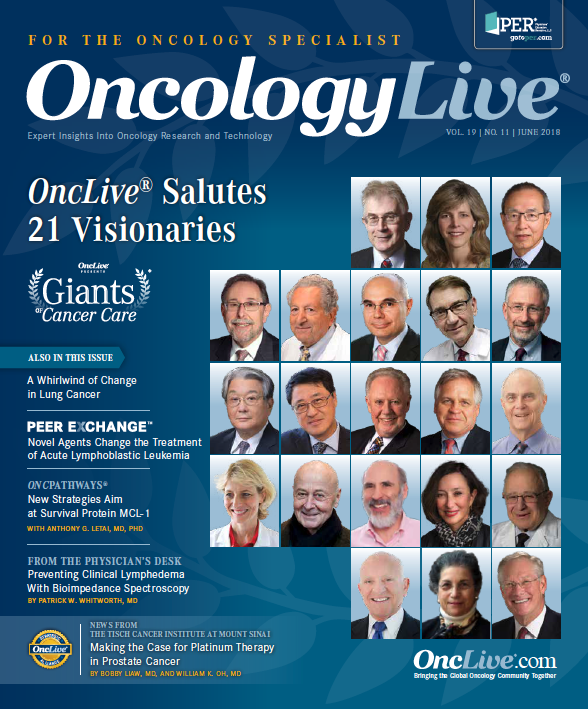Novel Immunotherapy Shows Early Efficacy in Uveal Melanoma
IMCgp100, a novel immune-based treatment, demonstrated a 1-year survival rate of 73% for patients with heavily pretreated, which is nearly double the historical expectations for patients with the disease.
Richard D. Carvajal, MD

Richard D. Carvajal, MD
IMCgp100, a novel immune-based treatment, demonstrated a 1-year survival rate of 73% (95% CI, 46%-88%) for patients with heavily pretreated, advanced uveal melanoma, which is nearly double the historical expectations for patients with the disease, according to lead investigator Richard D. Carvajal, MD.
At a median follow-up of 12.8 months, the median overall survival had not yet been reached in the phase I study. The objective response rate with IMCgp100 was 11% among (90% CI, 2%-30%), with 5 additional patients (26%) showing signs of stable disease with minor responses (≥10% reduction in target lesions). The median progression- free survival (PFS) with the treatment was 24.3 weeks, and 62% of patients remained alive and progression free at 1 year (Table).
“Advanced uveal melanoma has a 1-year overall survival rate of approximately 40%, and no cytotoxic, targeted, or immunological therapy has been previously identified to meaningfully improve outcomes,” Carvajal said at the Association for Research in Vision and Ophthalmology (ARVO) 2018 Annual Meeting, where he presented the data. Carvajal is director of Experimental Therapeutics and the Melanoma Service at Columbia University Medical Center in New York, New York.
Table. IMCGP100 Clinical Efficacy Findings
Dose Escalation Strategy
“The 73% 1-year overall survival we observed in the heavily pretreated patients with metastatic uveal melanoma treated with IMCgp100 is quite notable,” he said. “We are excited about the continued development of IMCgp100 for patients with this disease.” IMCgp100 is the leading candidate in a new class of investigational therapies targeting the T-cell receptor (TCR) called immune-mobilizing monoclonal T-cell receptors. It contains 2 functional ends, 1 that targets the soluble affinity—enhanced TCR and the other an anti-CD3 single-chain variable fragment. The TCR end binds to the melanoma-associated antigen gp100, and the effector end activates an antitumor CD3-positive T-cell response.The dose escalation study included 19 patients across 4 dose levels ranging from 54 μg to 73 μg. The study utilized an intrapatient escalation strategy: on day 1 of the first cycle, patients received IMCgp100 at 20 μg, which was escalated to 30 mcg on day 2 of cycle 2. This was followed by enrollment to 1 of 4 cohorts testing a range of doses (54 μg, 64 μg, 73 μg, and 68 μg).
Dose-limiting toxicity in the form of abnormal liver function tests was observed in 3 patients. Two of these events were seen in the 4 patients who received the highest dose, which was subsequently reduced to 68 μg. This dose was identified as the maximum tolerated dose of IMCgp100 and will be further explored in phase II trials.
The median age of patients was 55 years, and the ECOG performance scores were 0 (74%) and 1 (26%). Participants had undergone a median number of 4 prior therapies (range, 0-8), which included chemotherapy for 95% of patients and prior immunotherapy for 68%. Prior immune therapy included ipilimumab (47%), pembrolizumab (32%), and nivolumab (16%). All patients had liver metastases, and lactate dehydrogenase levels were greater than the upper limit of normal for 73% of patients.
In terms of responses, the median time to objective response was 27.8 weeks and the median duration was 24.1 weeks. The disease control rate (responses plus stable disease) was 53% at week 16 and 32% at week 24. There were no complete responses, and 26% of patients developed progressive disease as their best response, which occurred mostly in doses below 68 μg.
A pharmacokinetic (PK) analysis of the study showed consistent dose-dependent activity. The half-life for the drug was determined to be 6 to 8 hours across all doses above 20 μg.
Evidence of T-cell infiltration was seen using immunofluorescence in pharmacodynamic assessments. Immune activation was seen in the tumor after 3 weekly doses of IMCgp100, which was consistent with T cell redirection, the researchers noted.
Following treatment, there was a temporary reversible decrease in peripheral lymphocyte counts, which is indicative of lymphocyte trafficking. Immunofluorescence analysis of biopsy samples after 3 doses of IMCgp100 showed high levels of lymphocyte trafficking into the tumor, with persistent lymphocyte infiltration. At progression, there were high levels of PD-L1 expression, gp100 antigen expression, and CD8 T cells present in the tumor.
All patients in the study experienced treatment- emergent adverse events (TEAEs), with 79% having a grade 3/4 event. The most common all-grade TEAEs were pruritus (90%), pyrexia (84%), fatigue (84%), hypotension (74%), chills (63%), nausea (68%), dry skin (63%), and peripheral edema (63%). The most frequent grade 3/4 TEAEs were fatigue (16%), hypotension (16%), erythema (16%), and macular rash (11%).
The skin toxicity observed in approximately two-thirds of patients persisted during the first 4 weeks of treatment and then began to taper off. There were no grade 3/4 skin toxicity events beyond 4 weeks, and by week 7, skin toxicity events reached a plateau, with approximately 26% of patients having a rash beyond 100 days of treatment.
“While research is still ongoing, I am encouraged by the results from this phase I study in ocular melanoma. We are committed to progress research to benefit patients,” Carvajal said.
A pivotal phase II trial is enrolling participants with uveal melanoma to further test IMCgp100 compared with investigator’s choice of systemic therapy, which could include the CTLA-4 inhibitor ipilimumab or the anti—PD-1 agent pembrolizumab. The open-label phase II study plans to enroll 327 participants, with an estimated primary completion date of July 2020 (NCT03070392).
In addition, a phase II portion of the study reported at ARVO is now open for additional participants. This expansion cohort of the study hopes to enroll 150 patients. The estimated completion date for this expansion trial is December 2018 (NCT02570308).
Carvajal RD, Sacco J, Nathan P, et al. Safety, efficacy and biology of the gp100 TCR-based bispecific T cell redirector, IMCgp100 in advanced uveal melanoma in two phase 1 trials. Poster presented at: 2018 ARVO Annual Meeting; April 29-May 3, 2018; Honolulu, HI. Poster A0283.




